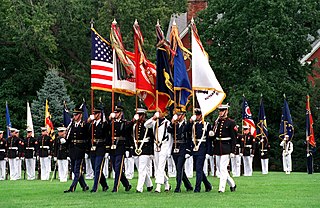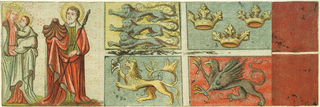
USS Winston S. Churchill (DDG-81) is an Arleigh Burke-class destroyer of the United States Navy. She is named after Sir Winston Churchill, former Prime Minister of the United Kingdom. This ship is the 31st destroyer of her class. Winston S. Churchill was the 18th ship of this class to be built at Bath Iron Works in Bath, Maine, and construction began on 7 May 1998. She was launched and christened on 17 April 1999. On 10 March 2001, she was commissioned during a ceremony at Town Point Park in Norfolk, Virginia.

The Union Jack, or Union Flag, is the de facto national flag of the United Kingdom. Although no law has been passed making the Union Flag the official national flag of the United Kingdom, it has effectively become such through precedent. The Union Flag was also used as the official flag of several British colonies and dominions before they adopted their own national flags. The flag continues to have official status in Canada, by parliamentary resolution, where it is known as the Royal Union Flag.

The national flag of Romania is a tricolour. The Constitution of Romania states that "The flag of Romania is tricolour; the colours are arranged vertically in the following order from the flagpole: blue, yellow, red". The flag has a width-length ratio of 2:3; the proportions, shades of colour as well as the flag protocol were established by law in 1994, and extended in 2001.

The ensign is a maritime flag that is used for the national identification of a ship. The ensign is the largest flag, generally flown at the stern (rear) of the ship while in port. In ports, depending on the ship's origin, it is sometimes identical with a jack on the bow of the ship. Jacks are more common on warships than on merchant ships.

The Red Ensign or "Red Duster" is the civil ensign of the United Kingdom of Great Britain and Northern Ireland. It is one of the British ensigns, and it is used either plain or defaced with either a badge or a charge, mostly in the right half.

In British maritime law and custom, an ensign is the identifying flag flown to designate a British ship, either military or civilian. Such flags display the United Kingdom Union Flag in the canton, with either a red, white or blue field, dependent on whether the vessel is civilian, naval, or in a special category. These are known as the red, white, and blue ensigns respectively.

The several branches of the United States Armed Forces are represented by flags. Within the U.S. military, various flags fly on various occasions, and on various ships, bases, camps, and military academies.

A maritime flag is a flag designated for use on ships, boats, and other watercraft. Naval flags are considered important at sea and the rules and regulations for the flying of flags are strictly enforced. The flag flown is related to the country of registration: so much so that the word "flag" is often used symbolically as a metonym for "country of registration".

The White Ensign, at one time called the St George's Ensign because of the simultaneous existence of a crossless version of the flag, is an ensign worn on British Royal Navy ships and shore establishments. It consists of a red St George's Cross on a white field, identical to the flag of England except with the Union Flag in the upper canton.

The First Navy Jack was the naval jack of the United States from 1975 to 1976 and again from 2002 to 2019. It was authorized by the U.S. Navy and was flown from the jackstaff of commissioned vessels of the U.S. Navy while moored pierside or at anchor. Since then, it is used only as a naval jack by the oldest active warship in the U.S. Navy. The design is traditionally regarded as that of the first U.S. naval jack, flown soon after independence, but this is not supported by the historical record.

A pennon, also known as a pennant or pendant, is a long narrow flag which is larger at the hoist than at the fly, ie., the flag starts to narrow down as it moves away from the flagpole, when viewed from left to right. It can have several shapes, such as triangular, tapering or triangular swallowtail, etc. In maritime use, pennants are to be hung from the main truck.

The Australian White Ensign is a naval ensign used by ships of the Royal Australian Navy (RAN) from 1967 onwards. From the formation of the RAN until 1967, Australian warships used the British White Ensign as their ensign. However, this led to situations where Australian vessels were mistaken for British ships, and when Australia became involved in the Vietnam War, the RAN was effectively fighting under the flag of another, uninvolved nation. Proposals were made in 1965 for a unique Australian ensign, which was approved in 1966, and entered use in 1967.

The jack of the United States, referred to as the Union Jack by the U.S. Navy, is a maritime jack flag flown on the bow of U.S. vessels that are moored or anchored. In addition to commissioned U.S. Navy ships, the jack is used by the U.S. Coast Guard, the Military Sealift Command, the ships of the National Oceanic and Atmospheric Administration, and other U.S. government entities. While anchored or moored, the jack is flown on the bow of a ship, and the ensign is flown on the stern. Once under way, the jack is lowered.

The flag of the United States Navy consists of the seal of the U.S. Department of the Navy in the center, above a yellow scroll inscribed "United States Navy" in dark blue letters, against a dark blue background.

A French ensign is the flag flown at sea to identify a vessel as French. Several such ensigns have existed over the years as well as terrestrial flags based on the ensign motif.

A broad pennant is a triangular swallow-tailed naval pennant flown from the masthead of a warship afloat or a naval headquarters ashore to indicate the presence of either:

The Office of Marine and Aviation Operations (OMAO) is a division of the National Oceanic and Atmospheric Administration (NOAA) which operates a wide variety of specialized ships and aircraft to carry out the environmental and scientific missions of NOAA.

The ensign of the United States is the flag of the United States when worn as an ensign. International maritime law—see International Treaty on Law of the Sea, articles 91 and 92—provides that vessels have a "national character" and thus should display a flag (ensign) that corresponds to this national character, especially when in international or foreign waters. Vessels that are formally documented under the federal vessel documentation act, vessels owned by government bodies in the United States, and vessels in the U.S. military unquestionably have U.S. national character, and thus properly hoist a U.S. ensign to show their national character. Vessels that are numbered by the states and small, non-registered craft owned by U.S. citizens and not registered in other countries may also hoist a U.S. ensign to show their national character.
A pendant is a piece of jewellery.




























